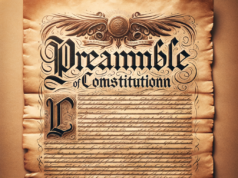Table of Contents

When Was the Constitution Written?
The Constitution of the United States of America is one of the most important documents in the history of the world. It outlines the fundamental principles and structure of the American government, and has served as a blueprint for many other constitutions around the globe. Its creation was a defining moment in American history, and its legacy is still felt today.
But when was the Constitution written? What were the circumstances that led to its creation, and who were the people who drafted it? In this article, we will explore the history of the Constitution, from its origins to its final adoption, and examine its significance both at the time of its creation and in the present day.
Origins of the Constitution
To understand the origins of the Constitution, we need to go back to the early days of the American colonies. The first European settlers arrived in what is now the United States in the early 17th century, and over the next several decades, various colonies were established in the region. These colonies were largely independent of each other, with their own governments and laws, but they were all subject to the authority of the British Crown.
In the mid-18th century, tensions began to erupt between the British colonists and their government in London. The colonists were upset about a variety of issues, including high taxes, restrictions on trade, and the lack of representation in the British Parliament. In response, they began to organize and protest, eventually leading to the start of the American Revolution in 1775.
During the Revolutionary War, the colonies established a loose confederation known as the Continental Congress. This body served as a kind of government for the colonies, but it was weak and ineffective, with limited powers and no ability to enforce its decisions. As the war drew to a close, it became clear that a more robust and effective central government was needed to secure the freedoms and interests of the new nation.
Debates and Discussions
In 1787, a group of delegates from the various states met in Philadelphia to begin the process of drafting a new constitution for the United States. These men were some of the most influential and brilliant thinkers of their time, including George Washington, Benjamin Franklin, James Madison, and Alexander Hamilton.
Their task was a difficult one. They had to balance the need for a strong central government with concerns about individual liberty and state sovereignty. They had to reconcile the competing interests and views of the various states, which had very different economies, cultures, and political traditions. And they had to create a system of government that could work effectively over a vast and diverse territory.
The process of writing the Constitution was long and complex. The delegates spent months debating and discussing various proposals and ideas. They drew on a wide range of sources, including classical philosophy, European political theory, and their own experiences with colonial and state governments.
One of the most contentious issues was the question of representation in the new government. Some delegates favored a unicameral legislature, in which each state would have equal representation. Others advocated for a bicameral legislature, with proportional representation based on population. Eventually, a compromise was reached: the House of Representatives would be based on population, while the Senate would have two members from each state.
Other key provisions of the Constitution included the establishment of a federal system, with power divided between the national government and the states; the separation of powers among the legislative, executive, and judicial branches; and the creation of a system of checks and balances to prevent any one branch from becoming too powerful.
The Constitution completed
In September 1787, the delegates finally completed their work and signed the finished document. But the process wasn’t over yet. The Constitution had to be ratified by at least nine of the thirteen states before it could go into effect.
This proved to be a difficult and contentious process. Many people were skeptical of the new government, fearing that it would be too powerful and would infringe on their individual rights. Others were concerned about the lack of a Bill of Rights, which they felt was needed to protect against government overreach.
To address these concerns, a series of ratification conventions were held in each state, where delegates debated the merits of the new Constitution. These debates were often fierce and heated, with passionate arguments on both sides.
In the end, however, the Constitution was ratified by all thirteen states, and it went into effect on March 4, 1789. George Washington was elected the first President of the United States, and a new era in American history began.
Significance of Constitution
The significance of the Constitution cannot be overstated. It established the foundation for a stable and effective central government, laid out a system of government that has endured for more than two centuries, and provided a framework for the protection of individual rights and freedoms.
The Constitution has been amended many times over the years, as the needs and priorities of the nation have changed. But its fundamental principles have remained constant, serving as a touchstone for generations of Americans.
In recent years, the Constitution has been the subject of renewed interest and debate. Some have questioned its relevance in a rapidly changing and complex world, arguing that it needs to be updated to reflect modern realities. Others have sought to restrict or narrow its provisions, claiming that they infringe on individual liberties or obstruct efficient governance.
These debates are likely to continue for years to come, and the Constitution will undoubtedly be a central focus of them. But no matter what happens, the Constitution will remain a powerful and enduring symbol of the ideals and values that have made America great.
Conclusion
In conclusion, the Constitution of the United States is a document that has shaped American history, politics, and culture since its creation in 1787. Its genesis was a long and complex process that involved some of the most brilliant thinkers of the time. Its provisions have served as a blueprint for many other constitutions around the world, and it continues to exert a powerful influence on American thought and governance today.
The Constitution has been the subject of many debates and discussions over the years, and it is likely to continue to be so for many more years to come. But despite all of the challenges and controversies that it has faced, the Constitution remains a source of pride and inspiration for Americans everywhere. It is a testament to the enduring power of democratic ideals and the capacity of human beings to work together to create a better world.
When Was the Constitution Written?
The Constitution of the United States is defined as the primary piece of administrative legislative responsibility for the authorization, classification, and authentication of legality concerning the relationship of the Federal Government of the United States and its collective citizens. The timeline existing in regards to a recounting of the Constitution of the United States’ authorship cannot be limited to a single date; this is due to the fact that the penning of the Constitution of the United States took place in a gradual fashion – various drafts and edits were instated prior to its subsequent ratification:
When Was the Constitution Written? (1785)
· A Convention was held at Mt. Vernon in order to discuss potential action with regard to the separation of the Potomac River with regard to the vague precepts conveyed within the Articles of Confederation with regard to territory
· Federalists Alexander Hamilton and James Madison, as well as pundits including Benjamin Franklin and George Washington, were in attendance – as a result of this meeting, the replacement of the Articles of Confederation in lieu of an updated legislature was proposed
· Inadequacies considered to be latent within the text of the Articles of Confederation were deemed to foster a weak Central Government, as well as the division of the 13 States; 2 elements that were considered to be harmful by the Founding Fathers
· This meeting prompted the penning of the United States Constitution
When Was the Constitution Written? (1787)
· Following the conference that took place in Mt. Vernon, the first draft of the Constitution of the United States was undergoing creation at the Philadelphia Convention, which took place on May 5th, 1787. Who wrote the constitution?
· Due to a variety of complication within the approval process – stemming from varying degrees of disapproval from the individual State legislature, the Constitution of the United States underwent a vast array of editing and adjustment
· The Final draft of the Constitution of the United States was ratified on September 17th, 1787; 12 of the 13 United States approved of the Constitution – Rhode Island was the only state that refused to ratify the Constitution
What is Constitution Day?
When the question asking “When was the Constitution Written” is posed, many individuals may experience uncertainty with regard to the provision of a suitable – and accurate response. However, Constitution Day – a day of observance that is considered a Federal Holiday, founded in order to celebrate the ratification of the Constitution of the United States – takes place on September 17th on an annual basis; yet, September 17th is the day that the Constitution of the United States was ratified – not written.


























